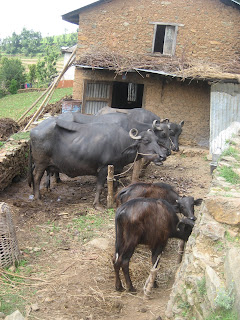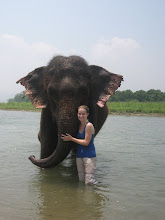Answer: Five Canadians.
Also, me.
Question: Guess who went twice???
Answer: Two brave Canadians.
Also, me.
!!!!
The option of bungee jumping has been brought before me several times since I arrived in Nepal. Each time I’ve brushed it off as something that is “not my thing.” Eventually, I started asking myself why in the world it’s “not my thing.” Do I have any other reason besides that I’m scared?
So when my travel plans for Saturday-Sunday were postponed, I decided to join my Canadian friends on their day-long excursion to Bhote Kosi, one of the top 5 best places to bungee jump in the world. It’s located about 12 km from the Tibetan border in a beautiful river gorge. The bungee jumping and all activities in the area are run by Last Resort, a beautiful resort and spa with hot springs, canyoning, and so much more. It’s absolutely gorgeous.
The bridge with the bungee jumping is 160 m in the air, which is about 550 feet from the river bed. The bridge actually freaks me out considerably because it’s a suspension bridge and moves really easily. We were initially divided into two groups based on weight. My group was scheduled to jump before lunch, and the other would jump after. It was a large crowd of jumpers – at least 40, I would say. I was one of the first people to jump based on weight, and managed to make quite a graceful dive off of the platform. I actually got a number of compliments from strangers who described the dive as swanlike and very graceful. So, thanks Dad, for the two years of diving lessons. They clearly paid off, in a very weird way.
The dive itself is both exhilarating and terrifying. There’s nothing in the world like it. I kept my eyes open the entire time and loved the feeling of the wind rushing around me and the river rushing below me. It’s indescribable.
Four others in our group dove after me (the rest of the Canada group went canyoning), then we hiked back up the hills in the pouring rain over waterfalls while following a steep, poorly marked path filled with plenty of leeches eager to suck my blood.
Motivated by our bungee jump, two of the girls and I decided to go ahead and try the “swing.” While you dive headfirst for bungee jumping, with the swing you jump feet first. Instead of being attached at the ankles and hips, you’re attached at the waist and chest. It’s the largest swing in the world –you fall for 7 or 8 seconds then swing across the river gorge.
So after lunch, three of us signed up to jump again with the afternoon bungee group. Both bungee and swing jump from the same place, but unlike with the bungee, you can do the swing in any order regardless of weight. Of course, I volunteered to go first out of the entire second group (I KNOW! I have no idea where this courage came from.) Unlike my bungee dive, however, I was considerably less graceful on this jump (flailing arms and legs = not so graceful). Also, I had an awkward scream. The swing is so cool, however, because you fall much closer to the river and then swing back and forth across the river valley. It’s an amazing view.
Anyway, I survived to tell you about it. I can’t imagine this bravery will last through my return to the U.S., so don’t start making any plans to take me sky diving or anything when I return. There will be a video of my dive, but I can’t pick it up for a few days. So here’s a photo of the valley to tide you over.
In other news, I spent Wednesday through Friday in Bhaktapur at a camp for 31 students from 10 schools in the Kathmandu Valley, and will be returning tomorrow to teach a session at a camp for ECCA counselors. Next weekend I’m heading to Pohkara for a few days, and then I have just one month left in Nepal! So crazy how time has flown by, and how much I still have left to do. The monsoon rains have also started here, which has cooled off the city considerably. It’s a nice change, but we’ll see if I’m still happy about it after days and days of rain.
I miss you all!
Love,
Lisa, bungee ballerina
The bridge itself.


























